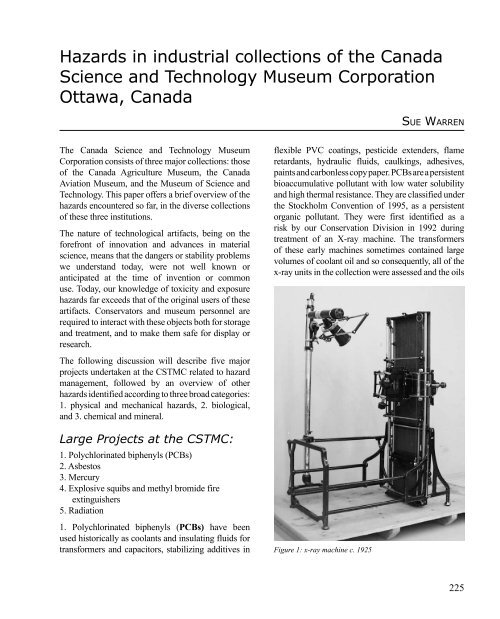dk nkf - Nordisk Konservatorforbund Danmark
dk nkf - Nordisk Konservatorforbund Danmark
dk nkf - Nordisk Konservatorforbund Danmark
You also want an ePaper? Increase the reach of your titles
YUMPU automatically turns print PDFs into web optimized ePapers that Google loves.
Hazards in industrial collections of the Canada<br />
Science and Technology Museum Corporation<br />
Ottawa, Canada<br />
The Canada Science and Technology Museum<br />
Corporation consists of three major collections: those<br />
of the Canada Agriculture Museum, the Canada<br />
Aviation Museum, and the Museum of Science and<br />
Technology. This paper offers a brief overview of the<br />
hazards encountered so far, in the diverse collections<br />
of these three institutions.<br />
The nature of technological artifacts, being on the<br />
forefront of innovation and advances in material<br />
science, means that the dangers or stability problems<br />
we understand today, were not well known or<br />
anticipated at the time of invention or common<br />
use. Today, our knowledge of toxicity and exposure<br />
hazards far exceeds that of the original users of these<br />
artifacts. Conservators and museum personnel are<br />
required to interact with these objects both for storage<br />
and treatment, and to make them safe for display or<br />
research.<br />
The following discussion will describe five major<br />
projects undertaken at the CSTMC related to hazard<br />
management, followed by an overview of other<br />
hazards identified according to three broad categories:<br />
1. physical and mechanical hazards, 2. biological,<br />
and 3. chemical and mineral.<br />
Large Projects at the CSTMC:<br />
1. Polychlorinated biphenyls (PCBs)<br />
2. Asbestos<br />
3. Mercury<br />
4. Explosive squibs and methyl bromide fire<br />
extinguishers<br />
5. Radiation<br />
1. Polychlorinated biphenyls (PCBs) have been<br />
used historically as coolants and insulating fluids for<br />
transformers and capacitors, stabilizing additives in<br />
flexible PVC coatings, pesticide extenders, flame<br />
retardants, hydraulic fluids, caulkings, adhesives,<br />
paints and carbonless copy paper. PCBs are a persistent<br />
bioaccumulative pollutant with low water solubility<br />
and high thermal resistance. They are classified under<br />
the Stockholm Convention of 1995, as a persistent<br />
organic pollutant. They were first identified as a<br />
risk by our Conservation Division in 1992 during<br />
treatment of an X-ray machine. The transformers<br />
of these early machines sometimes contained large<br />
volumes of coolant oil and so consequently, all of the<br />
x-ray units in the collection were assessed and the oils<br />
Figure 1: x-ray machine c. 1925<br />
sue warren<br />
225

















